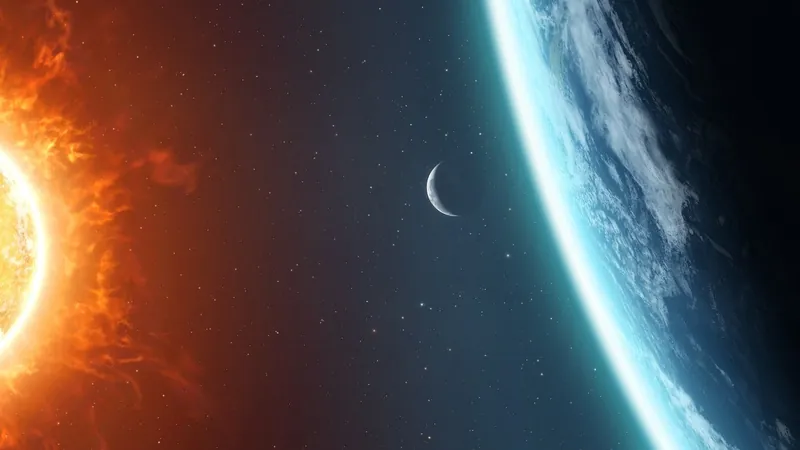
Shocking New Research Unveils the Hidden Effects of Climate Change on Arctic Soil Carbon!
2024-10-03
Introduction
In groundbreaking new research led by a team from Colorado State University, scientists have made startling discoveries about the intricate relationships among Arctic plants, soil microbes, and nutrients, shedding light on how climate change could influence vital carbon reservoirs trapped in Arctic permafrost.
The Significance of Arctic Soil Carbon
Arctic soils are estimated to hold nearly twice the amount of carbon currently present in our atmosphere. As global temperatures rise and the polar regions continue to thaw, a pressing concern arises: the potential release of vast quantities of carbon dioxide and methane—a process primarily driven by soil-dwelling microbes.
New Insights into Ecosystem Dynamics
Traditionally, studies have emphasized how rising temperatures jeopardize the stability of carbon locked underground. However, this new research reveals that warming impacts Arctic ecosystems in multifaceted ways. Changes in plant productivity, the types of vegetation present, and shifts in soil nutrient dynamics could all play significant roles in altering carbon cycling from soil to atmosphere. This revelation comes from a study published in Nature Climate Change.
Shrub-ification of the Arctic
One notable phenomenon observed in the Arctic is the “shrub-ification” of the landscape, where an increase in shrub growth and abundance has been documented. Surprisingly, this study suggests that over the long term, these shrubs may help retain more carbon in the soil. Dr. Laurel Lynch, co-author and an assistant professor at the University of Idaho, noted, 'While direct warming effects on soil carbon have garnered a lot of attention, our findings indicate that the interplay within this ecosystem is much more complex.'
Long-Term Ecological Research
This research builds on a 35-year-long ecosystem experiment at the Arctic Long-Term Ecological Research site near Toolik Lake in northern Alaska, where scientists have been examining how nutrient additions have affected soil carbon dynamics. Initially, after 20 years of adding nutrients, the team found significant soil carbon loss in comparison to control plots. However, after 35 years, unexpected results emerged: the carbon levels in nutrient-enriched plots either stabilized or even increased, countering the earlier trends.
Advanced Isotope Tracing Experiments
To deepen their understanding, Machmuller and her team conducted advanced isotope tracing experiments to investigate the flow of carbon within the soil ecosystem. Initial nutrient additions had stimulated microbial decomposition, releasing carbon dioxide into the atmosphere. Over time, however, the continuous nutrient input shifted microbial activity, slowing decomposition rates and allowing carbon stocks to rebuild—a finding that took researchers by surprise.
Conclusion and Implications
The implications of these findings extend beyond carbon storage. As Lynch pointed out, while increased shrub dominance might temporarily retain carbon, it poses a threat to biodiversity. A monoculture of one plant species could disrupt habitats and food sources essential for various Arctic wildlife.
Dr. Lauren Gifford, an expert in soil carbon dynamics albeit not involved in the study, emphasized the need for sophisticated modeling to grasp how climate change will shape future carbon balances in the Arctic. 'This extensive research highlights that despite rigorous long-term studies, the consequences of climate change can still be unpredictable.'
In closing, Machmuller expressed hope that this work will inspire further investigation, noting, 'Understanding the role of carbon in the Arctic is increasingly critical as we confront climate change. Yet, significant uncertainties remain about the future balance of carbon in this vulnerable region.' With the stakes so high, we must continue to explore this vital area of research to safeguard our planet's climate.









 Brasil (PT)
Brasil (PT)
 Canada (EN)
Canada (EN)
 Chile (ES)
Chile (ES)
 España (ES)
España (ES)
 France (FR)
France (FR)
 Hong Kong (EN)
Hong Kong (EN)
 Italia (IT)
Italia (IT)
 日本 (JA)
日本 (JA)
 Magyarország (HU)
Magyarország (HU)
 Norge (NO)
Norge (NO)
 Polska (PL)
Polska (PL)
 Schweiz (DE)
Schweiz (DE)
 Singapore (EN)
Singapore (EN)
 Sverige (SV)
Sverige (SV)
 Suomi (FI)
Suomi (FI)
 Türkiye (TR)
Türkiye (TR)